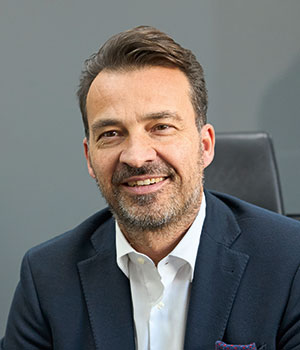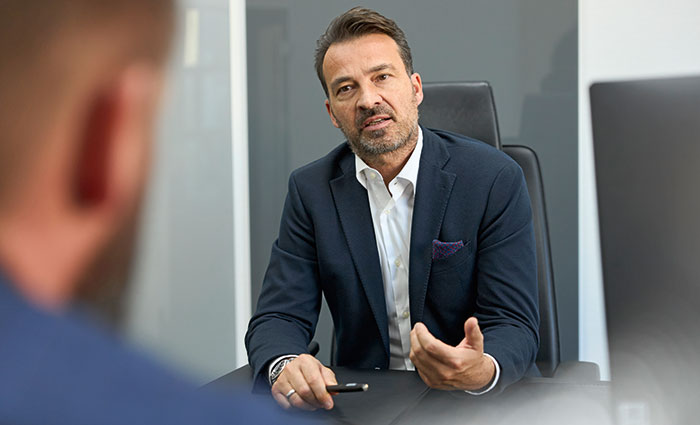Text Christian Vilsbeck, A&D ––– Photography
Mr Sonst, Stahlo is aiming to become a green steel provider. What exactly is “green steel”?
Although the term “green steel” is quite commonly used, there is no official, standardised definition of it. Steel differs according to how it is manufactured, such as the electric route that melts scrap materials in an electric arc furnace (EAF). By contrast, the conventional route manufactures raw steel in a blast furnace using ore and coking coal. At present, the term green steel refers to lower-emission versions of these production routes, as well as improved emissions quality across the entire supply chain. Green steel can be manufactured by smelting recycled scrap material using green electricity. Green steel can be expected to generate emissions at a level around 30 to 60 percent lower than conventional manufacture.
How much interest is there in green steel at the moment, in your experience?
There is enormous interest at the moment, since every company is obliged to address its emissions. Most companies have to define how they might optimise their operational processes over the next few years so as to achieve the targets of the Federal Climate Change Act by 2045. Steel manufacturers have already got themselves into position. Currently, many of them are favouring direct reduction as a technical solution. This process involves producing sponge iron, or “direct reduced iron”, from iron ore and – preferably green – hydrogen. The majority of leading steel manufacturers have already designed and project engineered such systems, in some cases with the help of subsidies. However, further corporate investment depends on whether a “green market” emerges. This remains to be seen.
Are you already arranging or procuring certain batches of green steel for your customers?
To safeguard availability, we have already concluded agreements with numerous steel plants about the supply of CO₂-optimised steel. We develop technical and economic emission-reduction roadmaps for our customers, based on their current steel usage, their targets, and the batches we have secured. We are also already in a position to procure CO₂- optimised steel – either steel manufactured using an EAF or highly optimised steel from a blast furnace. We recommend any customers who are interested in green steel to start planning early and not rely exclusively on future availability. After all, some analysts are already predicting supply bottlenecks for green steel of up to seven million metric tons in 2030.
Customers with high steel requirements should therefore start making advance agreements as soon as possible ...
That’s right – and I’m not just saying this out of self-interest. Vehicle manufacturers and major suppliers are already getting involved directly in steel plants or special projects so they can secure the significant volumes of green steel they need. They have realised that, after switching to a green electricity tariff, the CO₂ reductions achieved through green steel are the next-best way of optimising their own footprint. For these large companies, this is a way to guarantee their supply at an early stage. However, this is simply not practical for small- and medium-sized enterprises with an annual requirement of maybe only 5,000 or 10,000 metric tons of flat steel. As an independent steel service centre, this is where we come in. We can reserve this amount of green steel from a range of steel plants in advance. We offer complete transparency as regards planning and the costs across the various green steel products.
How can you provide your customers with the necessary transparency throughout the entire supply chain?
Our steel compass provides customers with transparency regarding what they are buying and the associated emissions. They can use our application to set their climate targets and we will calculate precisely how much of which material has to be combined, and how much it will cost. What’s more, we offer clear certification management so customers can be sure they are getting what they pay for. It is our goal to treat emissions like a material value and create transparency throughout the entire supply chain.
Are there already moves to standardise the documentation of emissions values for steel?
We are already some way down that road with the DMP digital material pass, which enables standardised test certification to EN 10168 for steel coils. This is how we intend to document batch characteristics such as emissions values and material properties. This transparency is extremely important for green steel in particular. We are already active in the automotive industry and are working with partners to share product and material passes. After all, the goal of ecosystems such as Manufacturing-X and Catena-X is to enable transparency throughout the entire supply chain in a standardised and shareable data format. We are leading the way with our DMP, as there is not yet anything comparable in the steel industry, so we are already able to offer customers a transparent solution that uses blockchain to keep it safe from manipulation. We think the most plausible route for future development definitely lies in the compliant transmission of data to the ecosystems I just mentioned. That’s why we attach great importance to ensuring our solution remains adaptable to the agile changes in requirements that may come in the future. After all, key rules of play and definitions have still to be agreed with all parties.
What is the price premium for green steel?
As a rule of thumb, steel manufacturers generally add a premium of about 20 eurocents per kilogram, which works out at around 200 euros per metric ton. This is for steel that is manufactured with emissions levels that are around 30 to 60 percent lower, which is equivalent to approximate CO₂ savings of 0.7 to 1.4 metric tons per metric ton of steel. By way of comparison, an emissions certificate in the ETS trading system currently costs around 90 euros per metric ton of CO₂.
What is the situation for Stahlo in terms of its own carbon footprint?
Since the beginning of 2022, we have only been using green electricity for our operational processes, which naturally has a positive effect on our footprint. As a result, we are using almost no fossil fuels anymore, except for some natural gas on particularly cold winter days to heat the workshops. Our carbon footprint is calculated by dividing our total emissions by the amount of steel produced. Currently, this value is around 3.6 kg of CO₂ per metric ton of processed steel. Our goal is to bring this down below three kilograms per metric ton. By electrifying our equipment, we have already made considerable progress and have cut our CO₂ emissions by half since 2020.
Why should customers turn to an independent steel provider such as Stahlo?
Customers benefit from the global availability of all steel products, which we, as an importer, can offer on an international basis and through our supply arrangements with leading steel plants in Europe. They also have the option of obtaining smaller amounts of special products from specific steel plants through us, and enjoy dependable security of supply. Our prices stay competitive. Furthermore, we can provide even small customers with access to environmentally friendly steel options. We are aiming to generate around 30 percent of our turnover through green steel by 2030. This equates to roughly 150,000 to 200,000 metric tons. Our customers also get complete planning certainty, since – as part of the Friedhelm Loh Group – we value honest partnerships and long-term relationships


